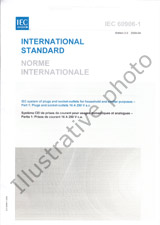We need your consent to use the individual data so that you can see information about your interests, among other things. Click "OK" to give your consent.

IEC 62282-3-200-ed.3.0
Fuel cell technologies - Part 3-200: Stationary fuel cell power systems - Performance test methods
Translate name
STANDARD published on 25.9.2025
The information about the standard:
Designation standards: IEC 62282-3-200-ed.3.0
Publication date standards: 25.9.2025
SKU: NS-1241915
The number of pages: 160
Approximate weight : 511 g (1.13 lbs)
Country: International technical standard
Category: Technical standards IEC
The category - similar standards:
Annotation of standard text IEC 62282-3-200-ed.3.0 :
IEC 62282-3-200:2025 covers operational and environmental aspects of the stationary fuel cell power systems performance. The test methods apply as follows: - power output under specified operating and transient conditions; - electrical and heat recovery efficiency under specified operating conditions; - environmental characteristics, for example, exhaust gas emissions, noise, under specified operating and transient conditions. This document applies to all kinds of stationary fuel cell technologies, such as: - alkaline fuel cells (AFC); - phosphoric acid fuel cells (PAFC); - polymer electrolyte fuel cells (PEFC); - molten carbonate fuel cells (MCFC); - solid oxide fuel cells (SOFC). This third edition cancels and replaces the second edition published in 2015. This edition includes the following significant technical changes with respect to the previous edition: - revision of the Introduction, Scope and Clause 3; - revision of the symbols in Table 1; - revision of Figure 2 (symbol diagram); - revision of measurement methods (8.3); - revision of the efficiency test (10.2); - revision of the electric power and thermal power response characteristics test (10.3); - revision of the start-up and shutdown characteristics test (10.4); - revision of Annex C. L’IEC 62282-3-200:2025 couvre les aspects de fonctionnement et d’environnement des performances des systemes a piles a combustible stationnaires. Les methodes d’essai s’appliquent comme suit: - puissance de sortie dans des conditions de fonctionnement specifiees y compris les conditions transitoires; - rendement electrique et rendement de l’energie thermique recuperee dans des conditions de fonctionnement specifiees; - caracteristiques d’environnement, par exemple emissions de gaz d’echappement, bruit, dans des conditions de fonctionnement specifiees y compris les conditions transitoires. Le present document s’applique a toutes sortes de technologies des piles a combustible stationnaires, telles que: - piles a combustible alcalines (AFC); - piles a combustible a acide phosphorique (PAFC); - piles a combustible a electrolyte polymere (PEFC); - piles a combustible a carbonates fondus (MCFC); - piles a combustible a oxyde solide (SOFC). Cette troisieme edition annule et remplace la deuxieme edition parue en 2015. Cette edition inclut les modifications techniques majeures suivantes par rapport a l’edition precedente: - revision de l’Introduction, du Domaine d’application et de l’Article 3; - revision des symboles enumeres dans le Tableau 1; - revision de la Figure 2 (schema des symboles); - revision des methodes de mesure (8.3); - revision de l’essai de rendement (10.2); - revision de l’essai des caracteristiques de reponse de puissance electrique et de puissance thermique (10.3); - revision de l’essai des caracteristiques de demarrage/d’arret (10.4); - revision de l’Annexe C.
We recommend:
Technical standards updating
Do you want to make sure you use only the valid technical standards?
We can offer you a solution which will provide you a monthly overview concerning the updating of standards which you use.
Would you like to know more? Look at this page.



 Cookies
Cookies
